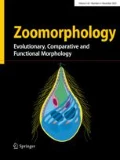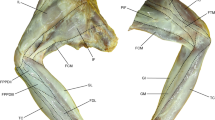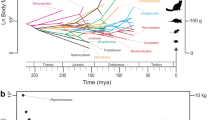Abstract
A characteristical feature of a raptors’ hindlimb is their strengthen musculature that aids gripping prey with their sharp talons. To trace specific anatomical modifications it is necessary to study closely related species, with this aim, the myology of the hindlimb of the three subfamilies of Falconidae is explored. For this, a description of a Herpetotherinae member (Micrastur ruficollis) was made for the first time. The hindlimb muscle mass of Polyborinae, Falconinae and Herpetotherinae was compared according to their main function (flexion and extension) on their joints (femur, tibiotarsus, tarsometatarsus and digits). The pattern of Micrastur ruficollis resembles that of the Falconidae except for a few differences towards the development of certain muscles. As it is noteworthy the presence of the second belly of the musculus flexor cruris medialis (unique among birds), its identity will be discussed. Also, Micrastur ruficollis had the highest values of the hindlimb mass. Polyborinae and Falconinae had several differences between each other. The muscles mass of the hip and knee, both flexion and extension, were higher in the Polyborinae, this is in accordance to their more terrestrial habit. Instead, Falconinae had a higher mass in the m. flexor digitorum longus, m. flexor hallucis longus and m. tibialis cranialis, the most important muscles for gripping prey.



Similar content being viewed by others
References
Backus SB, Sustaita D, Odhner LU, Dollar AM (2015) Mechanical analysis of avian feet: multiarticular muscles in grasping and perching. R Soc Open Sci 2:140350. doi:10.1098/rsos.140350
Baumel JJ, King SA, Breazile JE, Evans HE, Vanden Berge JC (1993) Handbook of avian anatomy. Publication of the Nuttal Ornitological Club N° 23, Cambridge
Bennett MB, Stafford JA (1988) Tensile properties of calcified and uncalcified avian tendons. J Zool 214:343–351
Berger AJ (1952) The comparative functional morphology of the pelvic appendage in three genera of Cuculidae. Am Midl Nat J 47:513–605
Berger AJ (1956) The appendicular myology of the Pygmy Falcon (Polihierax semitorquatus). Am Midl Nat J 55:326–333
Bierregaard RO (1994) Crested Caracara. P. 250 in del Hoyo J, Elliott A, Sargatal J (eds) Handbook of birds of the world. Vol. 2. New World vultures to guineafowl. Lynx Edicions, Barcelona
Biondi LM, Bó MS, Favero M (2005) Dieta del chimango (Milvago Chimango) durante el periodo reproductivo en el sudeste de la provincia de Buenos Aires, Argentina. Ornitología Neotropical 16:31–42
Bó MS, Baladrón A, Biondi LM (2007) Ecología trófica de Falconiformes y Estrigiformes: Tiempo de síntesis. Hornero 22:97–115.
Bock WJ (1965) The role of adaptive mechanisms in the evolution of higher levels of organization. Syst Zool 14:272–287
Bock WJ (1974) Philosophical foundations of classical evolutionary classification. Syst Zool 22:375–392
Brown LH, Amadon D (1968) Eagles, hawks, and falcons of the world. Country Life Books, London
Cade TJ (1982) Falcons of the world. Cornell University Press, Ithaca, NY
Conroy RM, Weigl PD, Clark JC, Ward AB. 1997. Functional morphology of owl hindlimbs: implications for prey selection and resource partitioning. Am Zool 37:37 A
Dickinson EC (2003) The Howard and Moore Complete Checklist of the Birds of the World. Third ed [M]. Princeton University Press, London, p 606
Dunning JB (2008) Handbook of avian body masses. CRC, Boca Raton
Engles WL (1940) Structural adaptations in the Thrashers. University of California publications. Zoology 42(7):341–400
Fisher HI (1957) The function of m. depressor caudae and m. caudofemoralis in pigeons. Auk 7:479–486
Fuchs J, Chen S, Johnson JA, Mindell DP (2011) Pliocene diversification within the South American forest-falcons (Falconidae: Micrastur). Molecular Phylogenetic. Evol Int J org Evol 60:398–407
Fuchs J, Johnson JA, Mindell DP (2012) Molecular systematic of the caracaras and allies (Falconidae: Polyborinae) inferred from mitochondrial and nuclear sequence data. Ibis 154:520–532
Fuchs J, Johnson JA, Mindell DP (2015) Rapid diversification of falcons (Aves: Falconidae) due to expansion of open habitats in the Late Miocene. Mol Phylogenet Evol 82:166–182
Goslow GE (1967) The functional analysis of the striking mechanisms of raptorial birds. Ph.D. University of California, dissertation
Gatesy SM (1999) Guineafowl hindlimb function. II. Electromyographic analysis and motor pattern evolution. J Morphol 240:127–142
Gatesy SM, Dial KP (1993) Tail muscle activity patterns in walking and flying pigeons (Columba livia). J Exp Biol 176:55–76
George JC, Berger AJ (1966) Avian myology. Academic, New York, p 500
GRIN (Global Raptor Information Network) (2016) Species account. http://www.globalraptors.org/grin/indexAlt.asp
Harcourt-Brown N (2001) Radiographicmorphology of the pelvic limb of Falconiformes and its taxonomic implications. Netherlands. J Zool 51:155–178
Hartman FA (1961) Locomotor mechanisms of birds. Smithsonian Misc Collect 143:1–91
Hudson GE (1937) Studies on the muscles of the pelvic appendages in birds. Am Midl Nat J 18:1–108
Hudson GE (1948) Studies on the muscles of the pelvic appendage in birds II: The heterogeneous order Falconiformes. Am Midl Nat J 39:102–127
Ilyinsky VA (2008) Locomotor adaptations in the hindlimbs of owls: the Burrowing Owl (Athene cunicularia), compared to the Little Owl (Athene noctua). Oryctos 7:271–276.
Jacobson RD, Hollyday M (1982) A behavioral and electromyographic study of locomotion in the chick. J Neurophysiol 48:238–256
Jollie M (1976) A contribution to the morphology and phylogeny of the Falconiformes I. Evol Theory 1:285–298
Jollie M (1977a) A contribution to the morphology and phylogeny of the Falconiformes. Pt. II. Evol Theory 2:115–208
Jollie M (1977b) A contribution to the morphology and phylogeny of the Falconiformes. Pt. III. Evol Theory 2:209–300
Jollie M (1977c) A contribution to the morphology and phylogeny of the Falconiformes. Pt. IV. Evol Theory 3:1–142
Lieber RL (2002) Skeletal muscle structure, function, and plasticity: the physiological basis of rehabilitation. Lippincott Williams & Wilkins, Philadelphia, p 369
Mckitrick MC (1986) Individual variation in the flexor cruris lateralis muscle of the Tyrannidae (Aves: Passeriformes) and its possible significance. J Zool 209:251–270
Mckricit MC (1993) Trends in the evolution of hindlimb musculature in aerial-foraging birds. Auk 110(2):189–206
Mosto MC (2014) Estructura y función del complejo apendicular posterior en rapaces diurnas (Falconidae y Accipitridae). PhD Thesis. La Plata: Facultad de Ciencias Naturales y Museo. II volumes 240 p. http://naturalis.fcnym.unlp.edu.ar/id/20140603001348
Mosto MC, Tambussi CP (2014) Qualitative and quantitative analysis of talons of diurnal bird of prey. Anat Histol Embryol 43:6–15
Mosto MC, Carril J, Picasso MBJ (2013) The hindlimb myology of Milvago chimango (Polyborinae, Falconidae). J Morphol 274:1191–1201
Mosto MC, Picasso MBJ, Biondi LM (2016) Long-legged Caracaras: terrestrial habitat and hindlimb morphology. J Zool 298:274–284
Picasso MBJ (2015) Ontogenetic Scaling of the Hindlimb Muscles of the Greater Rhea (Rhea americana) Anatomia, Histologia. Embryololgia 44:452–459
Spring L (1965) Climbing and pecking adaptation in some North American woodpeckers. Condor 67(6):457–488
Stoessel A, Kilbourne BM, Fischer MS (2013) Morphological integration versus ecological plasticity in the avian pelvic limb skeleton. J Morphol 274:483–495
Sustaita D (2008) Musculoskeletal underpinnings to differences in killing behavior between North American accipiters (Falconiformes: Accipitridae) and falcons (Falconidae). J Morphol 269:283–301
Thorstrom R (2000) The food habits of sympatric forest-falcons during the breeding season in northeastern Guatemala. Raptor Res 34(3):196–202
Vanden Berge J, Storer W (1995) Intratendinuos Ossification in birds: a review. J Morphol 226:47–77
Ward AB, Weigl PD, Conroy RM (2002) Functional morphology of raptor hindlimbs: implications for resource partitioning. Auk 119:1052–1063
White CM, Olsen PD, Kiff LE (1994) Family Falconidae (Falcons and Caracaras). In: del Hoyo J, Elliott A, Sargatal J, eds. Handbook of the birds of the World, Vol. 2: New World Vultures to Guinea fowl. Lynx Editions, Barcelona, pp 216–277
Acknowledgements
This paper was possible thanks to the access of materials by Yolanda Davies (Museo Bernadino Rivadavia, MACN), GP Guillermo Gil and Tec. Marcelo Cavicchia (Parque Nacional Nahuel Huapi PN° 1380). Thanks to Mariana Picasso for always giving a detailed reading and suggestions for the improvement of this paper, to Erica San Martín for the improvement of the English and Guillermo Cassini for his guidance on some of the contents of this MS and for his (I assume) great patience.
Author information
Authors and Affiliations
Corresponding author
Rights and permissions
About this article
Cite this article
Mosto, M.C. Comparative hindlimb myology within the family Falconidae. Zoomorphology 136, 241–250 (2017). https://doi.org/10.1007/s00435-017-0343-1
Received:
Revised:
Accepted:
Published:
Issue Date:
DOI: https://doi.org/10.1007/s00435-017-0343-1




